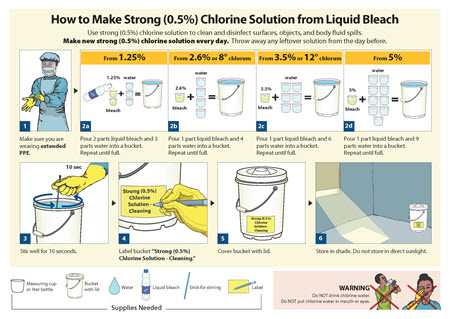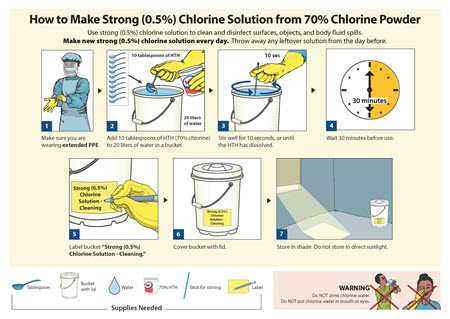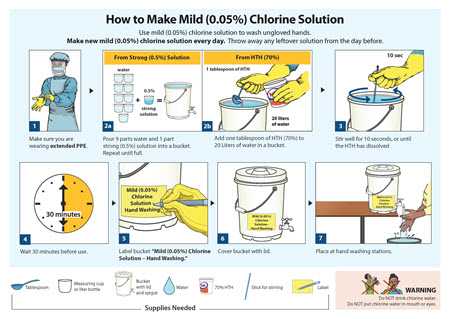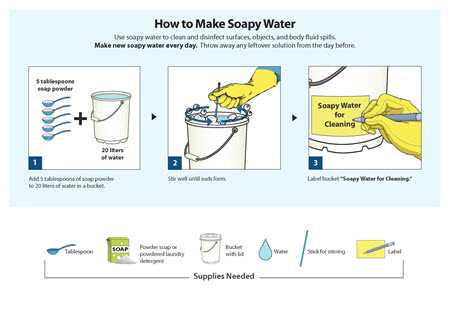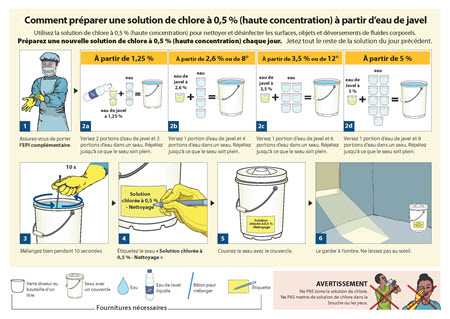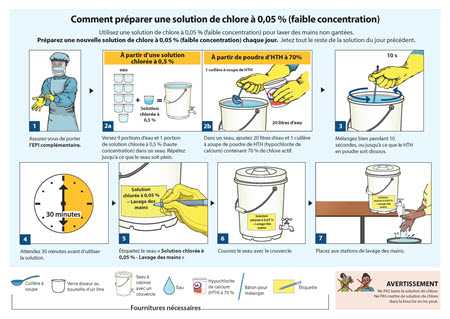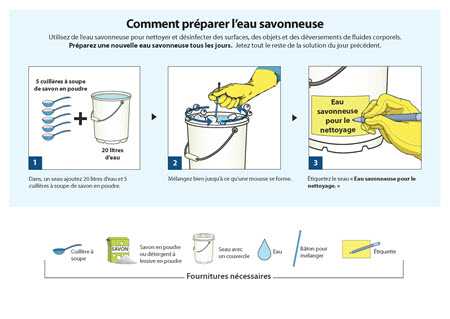For General Healthcare Settings in West Africa: How to Prepare and Use Chlorine Solutions
Page Summary
Who this is for: Healthcare providers working in healthcare settings in West Africa.
What this is for: This guidance demonstrates how to prepare and use chlorine solutions to prevent the spread of Ebola.
How to use: This guidance is intended to help healthcare workers prevent the spread of Ebola by mixing and using chlorine solution correctly.
Ebola virus disease (EVD) is spread through direct contact with the blood or body fluids of a person sick with EVD and by contact with contaminated surfaces or equipment, including linen soiled by infected body fluids. This type of spread can be prevented by mixing and using chlorine solutions correctly.
Key Points
- Mixing and using chlorine solution correctly can save lives by preventing Ebola virus from spreading.
- Chlorine solutions that are correctly mixed and applied will damage the Ebola virus and help prevent infection.
- Strong (0.5%) solution includes a higher concentration of HTH* (High Test Hypochlorite) chlorine that can be used for disinfecting floors and surfaces, medical equipment, bedding, and gloved hands.
- Mild (0.05%) solution can also be used for washing hands and to disinfect other things that have been used by healthcare workers or patients infected with EVD.
EVD is a severe illness that is highly infectious and rapidly fatal, but it can be prevented in part through proper disinfection of contaminated materials. The virus can be eliminated with hypochlorite (chlorine bleach) at appropriate concentrations. Correctly mixed and applied, chlorine solutions will damage Ebola virus on personal protective equipment (PPE) and other surfaces so that it can no longer infect patients and healthcare workers.
Two strengths of chlorine solution can be used by hospitals and clinics to disinfect for Ebola virus:
- Strong solution (0.5%) includes a higher concentration of HTH* (High Test Hypochlorite) chlorine that can be used for disinfecting surfaces, objects, medical equipment, and gloved hands. Other uses include
- Floors: Use a rag soaked in 0.5% solution to carefully clean up any body fluids. Then follow up with soap and water. If there is a lot of fluid, use a rag or towel to wipe up the fluid before using the chlorine solution followed by soap and water.
- Toilets and bathroom: Let chlorine solution stand on surface for 15 minutes before wiping off.
- Mattress covers: Let chlorine solution stand on surface for 15 minutes before wiping off.
- Foot baths.
- Contaminated waste for disposal.
- Corpses: Wipe body, body bag, and coffin.
- Layers of packaging for transporting blood samples: Spray each layer before packing into the next layer.
- Mild solution (0.05%) is a more gentle solution of HTH* chlorine that can be used for washing bare hands in settings where other methods, such as soap and running water or alcohol-based hand rubs, are not available or cannot be used. Warning: Washing bare hands with the strong solution (0.5%) can cause chlorine burns on hands. Mild solution can also be used to disinfect other things that come into direct contact with the skin or body, including
- Medical equipment, including thermometers.
- Patient bedding and clothing that is not visibly soiled: Soak in warm water and soap, then empty the drum of clothing and solution, and refill with mild chlorine solution. Soak in chlorine solution for 30 minutes.
- Plates, cups, and eating utensils.
- Everyday cleaning of surfaces and floors when there is no visible body fluids.
*High Test Hypochlorite (HTH) chlorinating granules (also known as Calcium Hypochloride, or CaOCl, or High Test Chlorine) can be carefully mixed with water to create some types of chlorine solutions used for cleaning or handwashing to protect against Ebola virus.
How to Prepare Chlorine Solutions
Chlorine solutions that are correctly mixed and applied will damage EVD on PPE and other surfaces to help prevent infection. Chlorine solutions are an important component of cleaning and disinfection procedures and must be made daily to be effective.
What You Need to Know
- Wait 30 minutes before using any chlorine solution that is made from powder.
- Chlorine solutions, depending on their use, should be transferred into bottles that have sprayers or into dispensers that have spigots.
- Chlorine solutions need to be labeled with their correct strength. Label strong with (0.5%) and mild as (0.05%).
- Chlorine solutions do not work as well on heavily soiled surfaces. Clean first, then disinfect.
- Keep the chlorine solution away from direct sunlight.
- Chlorine solutions lose strength over time, so make a fresh batch every day.
- Page last reviewed: February 27, 2015
- Page last updated: February 27, 2015
- Content source:


 ShareCompartir
ShareCompartir
